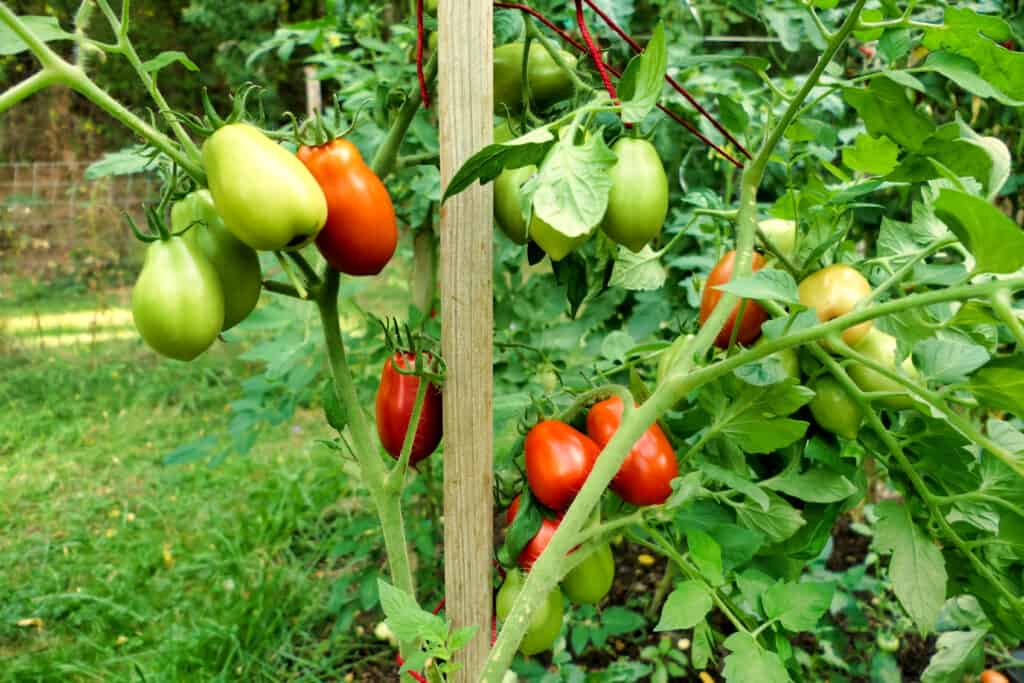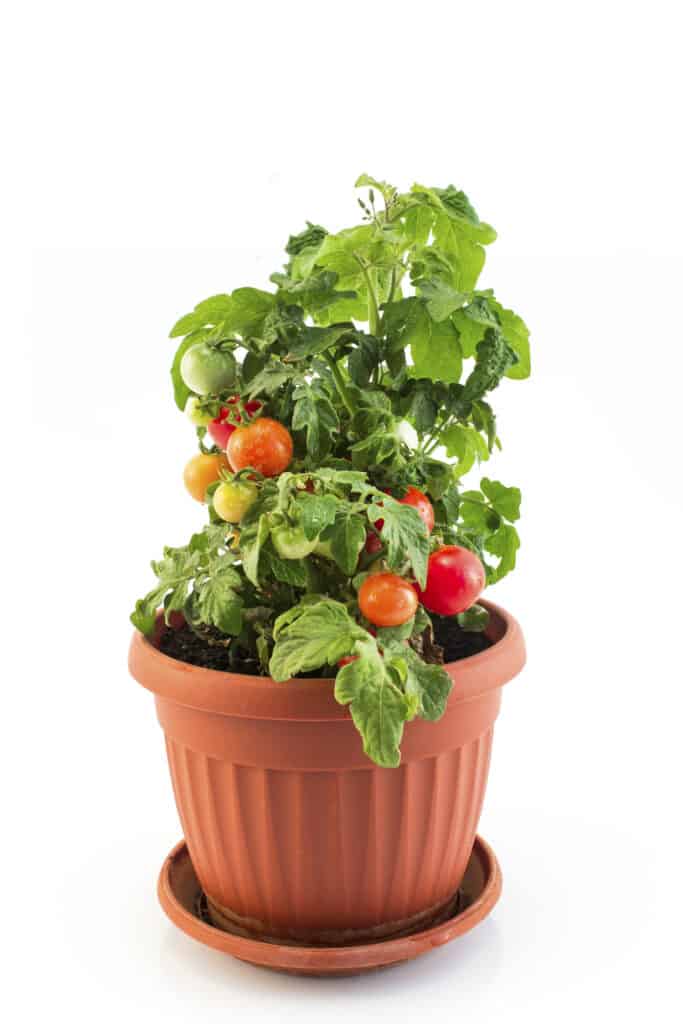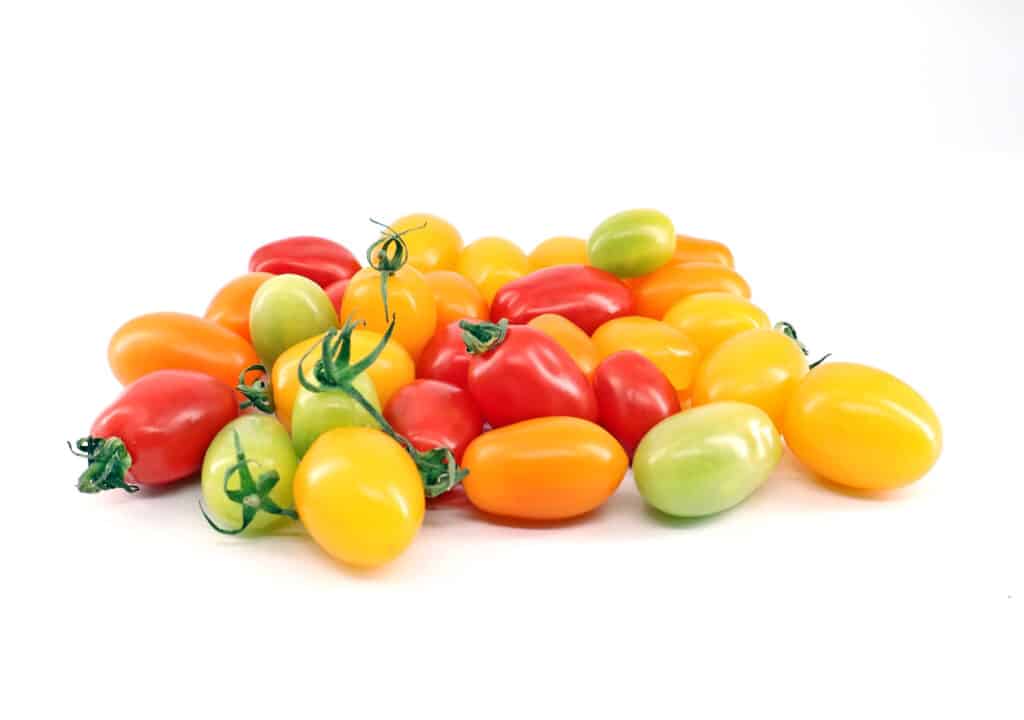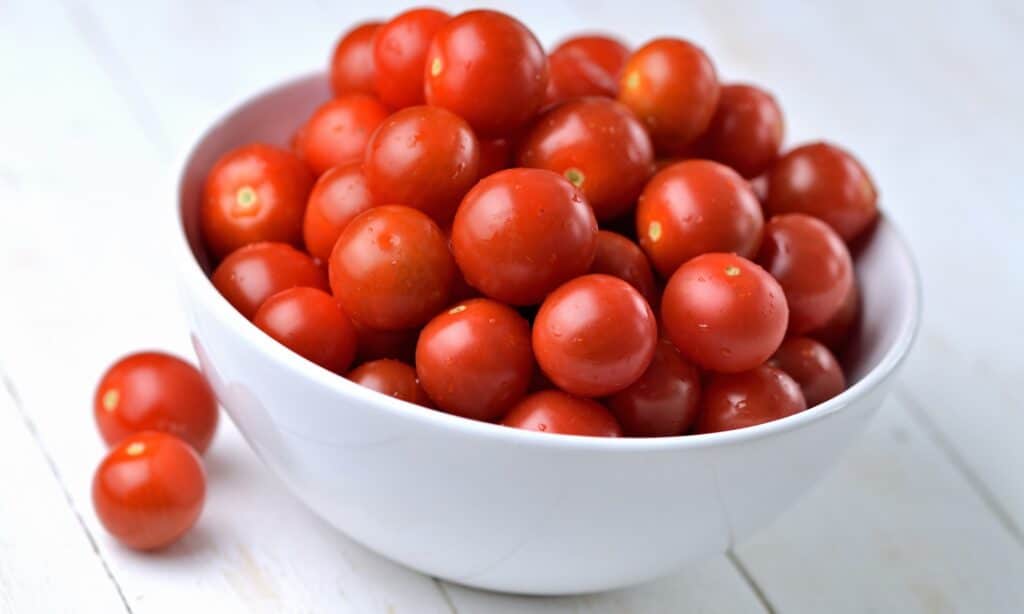Plum and cherry tomatoes are cute, bite-sized fruits that cooks the world over use more like vegetables. But, aside from size, there are some key differences between them.
In this article, we’ll discuss the main differences between plum tomatoes and cherry tomatoes so you’ll be able to distinguish between the two easily. Additionally, we will look at the best place to grow these two popular fruits, their features, origins, and the best way to use each of them.
| Plum Tomatoes | Cherry Tomatoes | |
|---|---|---|
| Shape | Oval | Round |
| Features | Color varies from orange yellow, red, and yellow They have high moisture content Have a sweet taste They have thick walls They are soft inside Have fewer seeds than cherry tomatoes | They are usually red, but can also be pink, orange, yellow, green, purple, or black. They are juicy They have a sour taste They are firm |
| Origin | Originated from South East Asia | They originated from Peruvian and Ecuadorian vines |
| Where Grown | Grow on upright plants | Grow on vines |
| Storage | Stores at room temperature and they can be kept in the fridge for many hours | Stored at room temperature but cannot survive in the fridge for many hours |
| Size | They reach 2-4 inches tall | Grows to 2-3 inches tall |
| Uses | Perfect for making pastes and sauces | Best for making salads and appetizers |
Let us take a deeper look into the key differences between plum tomatoes and cherry tomatoes.
Plum Tomatoes vs. Cherry Tomatoes: Uses

Plum tomatoes grow on vines that need to be staked in order to remain upright.
©iStock.com/PlazacCameraman
Also known as paste tomatoes or processing tomatoes, plum tomatoes are perfect for making sauces. What makes plum tomatoes a good fit for making tomato sauce is their lower water content. Compared to cherry tomatoes, plum tomatoes have a lower moisture content. The sweet acid flavor and the soft texture of plum tomatoes will guarantee you have a the perfect tomato sauce.
Also, plum tomatoes have fewer seeds compared to cherry tomatoes. This makes them a better option for sauce makers. You can also use plum tomatoes to make juice and tomato paste. When fresh, you can use plum tomatoes in salads, salsa, and sandwiches.
On the other hand, cherry tomatoes are a bit smaller and juicier than plum tomatoes. You can mix cherry tomatoes with different types of vegetables, fruits, and grains on cooked or uncooked salads. Cherry tomatoes are also an excellent choice for appetizers due to their small size and firm texture.
Plum Tomatoes vs. Cherry Tomatoes: Origin and Where to Grow

Cherry tomatoes grow on upright plants.
©iStock.com/simonidadjordjevic
It is evident that plum tomatoes and cherry tomatoes originated from different regions. This explains why they are similar, but not the same. Plum tomatoes originated from South East Asia. They are available in a wide variety of types, including small plum tomatoes, Italian plum tomatoes, San Marzano plum tomatoes, and Roma VF plum tomatoes. These tomatoes taste best when they’re fresh from the garden.
Experts believe that cherry tomatoes, on the other hand, originated in Peru and Ecuador. Later, they spread to other parts of the world. Cherry tomatoes come in a wide variety of colors, including pink, orange, yellow, green, purple, or black.
Cherry tomatoes are fast-growing, and they are cultivated in containers in a cage. For the cherry tomatoes to thrive well, they need to receive a minimum of eight hours of direct sunlight daily.
Plum Tomatoes vs. Cherry Tomatoes: Description

Plum tomatoes are easy to identify thanks to their oval shape.
©iStock.com/Luca Piccini Basile
The scientific name for all tomatoes, including plum and cherry tomatoes, is Solanum lycopersicum.
Plum tomatoes are easy to identify because of their shape and size. The plum tomatoes have an oval shape and may reach up to 4 inches long. Even though plum tomatoes have thick walls, on the inside, they are very soft. This makes them easy to cook.
These tomatoes are many chefs’ favorite tomatoes. This is because they are easy to handle thanks to their solid content and fewer seeds. Whenever you need to make tomato pastes and pasta sauces, plum tomatoes should be your go-to option. These tomatoes are not only best for cooking, you can also eat them while fresh.
Cherry tomatoes are not the perfect choice for pastes and sauces, but their sweet juice and higher water content makes them better for grilled or baked dishes. They are also the right choice for appetizers and salads.
You can easily identify cherry tomatoes because they are smaller than plum tomatoes and they’re round instead of oval and they are available in a variety of attractive colors. Cherry tomatoes can grow between 1-2 inches wide. The small size of these tomatoes mean that you can bite them with ease and enjoy the juice.
Plum Tomatoes vs. Cherry Tomatoes: Storage

Cherry tomatoes are round.
©iStock.com/CobraCZ
Both plum tomatoes and cherry tomatoes should always be stored at room temperature. Cherry tomatoes in particular should never be kept in the fridge because they’ll lose their freshness.
Plum tomatoes, on the other hand, can be stored in the fridge for many hours without going bad. The cold fridge temperature slows down the ripening process of these tomatoes. This helps to prolong their lifetime while keeping them fresh.
Plum Tomatoes vs. Cherry Tomatoes: Nutrition Comparison
The two tomatoes have a variety of health benefits for the human body.
- Both plum and cherry tomatoes have the same level of protein
- The level of saturated fat is low in both plum tomatoes and cherry tomatoes
- Both plum and cherry tomatoes have the same amount of Vitamin E
- Plum and cherry tomatoes have the same level of calcium
- Both cherry and plum tomatoes have the same level of iron content
However, the nutritional profile of these tomatoes differs in some respects. According to 2020 USDA and NIH data, 100 grams of plum tomatoes and cherry tomatoes has the following nutrients:
| Plum Tomatoes | Cherry Tomatoes |
|---|---|
| 46 calories | 16 calories |
| Have 72 per cent fewer carbohydrates than plum tomatoes | |
| Have 1.4g of dietary fiber | Have 0.9g of dietary fiber |
| Have more sugar than cherry tomatoes | |
| Are a better source of vitamin C than plum tomatoes | |
| Contain 341 per cent more Vitamin A than plum tomatoes | |
| Contain more Vitamin K than cherry tomatoes | |
| Contain 35% more potassium than plum tomatoes |
Up Next
- Grape Tomato vs. Cherry Tomato: Is There a Difference?
- Celebrity Tomato vs. Early Girl Tomato
- Can Dogs Eat Tomatoes, Are They Poisonous or Safe?
- Will Cicadas Eat My Tomato Plants?
The photo featured at the top of this post is © iStock.com/CobraCZ
Sources
- ACS Publications, Available here: https://pubs.acs.org/doi/abs/10.1021/jf020315t
- Research Gate, Available here: https://www.researchgate.net/publication/202280728_Evaluation_of_the_chemical_quality_of_a_new_type_of_small-sized_tomato_cultivar_the_plum_tomato_Lycopersicon_lycopersicum
- Science Direct, Available here: https://www.sciencedirect.com/topics/agricultural-and-biological-sciences/cherry-tomatoes
FAQs (Frequently Asked Questions)
Can you substitute cherry tomatoes for plum tomatoes?
You can use plum tomatoes as a substitute for cherry tomatoes while making salads and appetizers, but the final product will be a little dryer. That is because plum tomatoes have a lower liquid content compared to what cherry tomatoes produce.
What happens if you eat tomatoes every day?
Taking a lot of tomatoes can lead to heartburn in some people. Heartburn is caused by the production of too much gastric acid in your stomach, which can be caused by tomatoes. If you suffer from digestive stress, it would be best if you consume fewer tomatoes.
Are tomatoes full of sugar?
Even though tomatoes have a sweet taste, their sugar level is low. A cup of sliced tomatoes contains a single teaspoon of sugar.
Can grape tomatoes be used in place of cherry tomatoes?
Both cherry tomatoes and grape tomatoes can be used interchangeably when making salads. For you to get the best results while substituting cherry tomatoes for grape tomatoes, ensure you cut them into much smaller pieces.
Thank you for reading! Have some feedback for us? Contact the AZ Animals editorial team.






